CRM systems: what is it? Simple words
Where do you keep customers? On a piece of paper, on the phone, in the diary, in Excel? Or you are offered a CRM system for the umpteenth time, but you do not have a complete understanding of what it is and how it works.
This information is not for programmers, IT people, etc. It is for business owners who want to understand what a CRM system is. Do not read about the benefits, benefits, who needs it and what it gives, and above all understand. Most of the information on this topic is written in a very clever language. Even simple articles are written as if people are afraid to appear non-professional. And I ask you to forgive me if someone thinks that I wrote all this in a too simple language. I want you to understand and understand this, because you are good at your business, and did not consider me an expert.

')
So let's break the CRM system apart. What is the CRM system in business? Sales What do we need for sales? Customers Therefore, the first two most important things that we should have, and they are in any CRM system, these are customers and sales.

So. Customers Where do you keep customers? On a piece of paper, on the phone, in the diary, in Excel?
You yourself can confirm that all these options are not convenient because:
Here would save the card index. Like good old times.
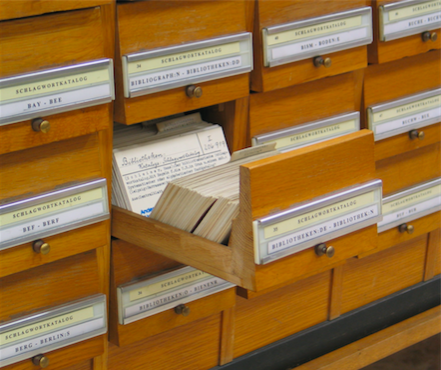
The solution is excellent. But there is a drawback. Speed!
However, the comparison with the file is good because everyone understands how the file works.
So let's transfer the principle of filing cabinets to a computer.
What do we have in the file cabinet? A bunch of cards of anything. In our case of customers.
So we will get a card for each client, as in a card index. In this card, we will store all the information on the client. We went into the card, and everything is in full view.
What information will we store?
The one that we need in order to successfully sell and make the right decisions. Such information on the client can be divided into two parts.
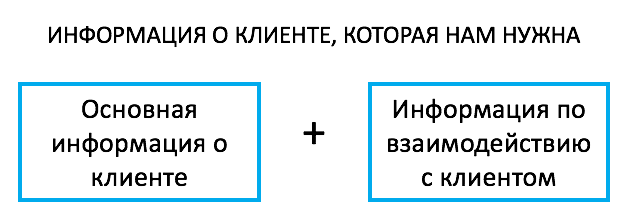
How will we store it?
Agree that in any system there must be order, otherwise it is no longer a system.
How would we do it in the file cabinet? In the simplest form, we would have the same fields for all customers and cards: telephone, mail, etc. In such fields we can easily put information on type 1.
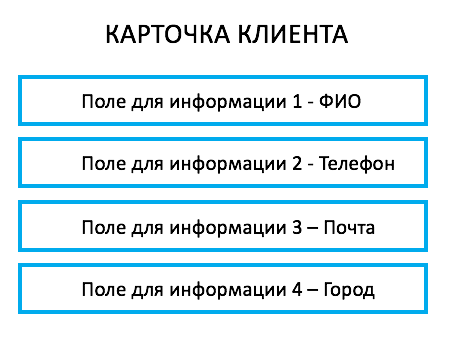
And what to do with all the information that is associated with customer interactions? She has one feature. It depends on the time. So we will arrange it depending on the time in order to first see the latest information, and then later.
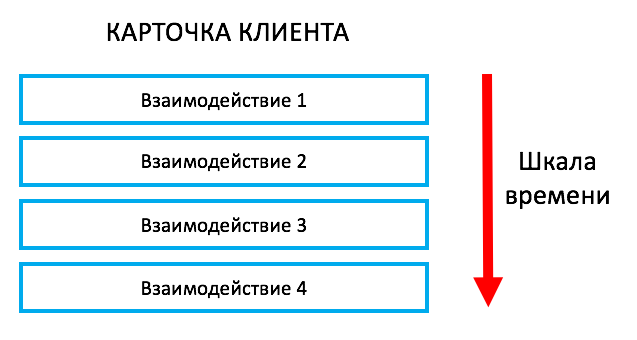
As a result, we have a client card, where all the basic information about the client is stored. It is located in the fields. In the picture below, these fields are on the left. All information about the interaction with the client is based on time. The picture below is on the right.

It remains to solve one more thing. We have not one but many clients. How are we going to post them all? In the card file all the cards are arranged in alphabetical order. In our case, nothing better than the list has not yet been invented.

Making a simple customer list. How many customers are on the list without us. Because we will find the clients we need or we need using a search or using a filter.
And if you enter any CRM system, you will see it. A list of clients, and each client has a card with information about him, as well as a search with a filter.
Thus, we got the first of the main parts of the CRM system. In fact, some of this is enough. Customers are already easy to search and information is not lost.
But someone is missing this. Therefore, let's go further. We want to see what we sold to the client!
What do we do with sales information?
We can indicate all sales information directly on the customer card. However, there are several disadvantages:
But there is a way out.
If we consider information about any sale, then, as in the case of a client, we will be able to break it into two parts:

Then there is a simple solution. If the client and the sale are so similar, then let's make the same card for the sale as for the client. Make a list of all sales, as well as customers, which will be easy to find the right one.
But the sale and the customer still have an important distinction. Selling, unlike the client, is a process. And like any process, it has stages. Those. the sale may begin - we have come into contact with the client, and may be completed - we have completed the sale, or not. There are also stages between the beginning and the end.
For example, first the seller communicates with the customer by phone, then he meets, then he makes a commercial offer to him, then he issues an invoice and receives payment. Each business has its own specifics and its stages. But they are always there. Just because any process has one. Even if you just want to leave the house, you first need to get dressed, open the door, then go out. Already at least three stages.

And it is not necessary that during the transition from the first stage to the last, it will be necessary to go through each stage. You can go outside without clothes. In sales, if a customer called you and said: “I want to buy,” and he knows specifically what he wants to buy, you will not insist on throwing him a commercial offer. You bill him. And in fact, you sell him a commercial offer without a stage. You jump over it. There is nothing wrong.
What do we do with the information on the stages?
In the case when we are dealing with a process and there are stages, it is very convenient to see immediately at what stage the process is located, in our case the sale. This is how to go to McDonalds and see on the electronic scoreboard whether your order is ready or not. So here. We just horizontally (in the picture below) have all the stages and under each stage of the sale, the sales that are on it are simply displayed.

Only one thing remains: to link sales and customers.
We have a customer list and a list of sales with cards. But while they are not related.
In fact, this is nothing complicated. For example, when you go to a contact or Facebook, you can go to the list of all friends and from all users of the social network see only your friends. Those. in essence, to see only those who are “friends” with you. So it is here.
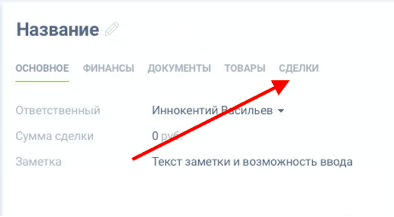
We will do so that there will be a section in the client’s card where we can go in and see a list of all the sales of this client and from there we can open the cards of these sales. We will do the same in the sale card so that it is easy to get into the customer card. It turns out that now we have customers and sales related.
This is what you will see when entering any CRM system:
To make it even clearer, we look at it all from above, like a football game from the stands.
We can consider a player in football as a player with his characteristics or as a point on the field, as one of 11 figures. Also, look at the top of contacts and customers.
To do this, we introduce a new concept. An entity is a distinguishable object; an object that we can distinguish from another. In our system, we will understand an entity as an entity that is displayed in some way (for example, in the form of a card), has its own input fields (for example, the client’s phone, mail, city; the transaction has a sum) and has connections (in our case, for example, the customer has sales links).
Those. customer and sale are separate entities. And they are connected to each other by connections as in the picture. Multiple sales can be made to one customer;

In order to fully work with customers, only one is missing.
We do not rarely forget that someone needs to call, write, etc. Someone for this uses a diary, someone alarm clock, and someone relies on memory.
Let's add just the opportunity to set ourselves tasks. Fortunately, everything is clear with the tasks. The only question is how they will be displayed in the system.
We use the concept of the essence that we have introduced. We agreed that we understand an entity as an object that is displayed in some way (in the case of a task, it can be a card, just not the same as for a sale and a client), but has its own input fields (for a task it’s deadline, priority and etc.) and has connections (the task is related either to the sale or to the contact).
Those. a task is an entity with its connections.

Where to put the tasks in the system?
First, it is most convenient that they are listed as contacts and sales.
Let's make a separate list, where all our tasks are displayed, in order to see them all and we will carry out them in order. And all of them are connected with the client or with the sale. Therefore, through them we easily get into the customer or sale.
And the second question to which we need to answer: Where to display the tasks in the client's card?
Having them as sales is not very convenient.
Tasks have one feature. The tasks themselves are closely related to the process of communication with the client. We call, communicate, then write a comment, set a task, send a letter. Then on the task again call or go to the meeting. Those. for them it is very important when tasks are set and when they need to be completed.
Therefore, let the tasks be displayed in the same place where the comments and calls. Where there is all the information about the interaction with the client, depending on the time.

If you enter almost any CRM system, you will see it. List of tasks and the ability to set tasks in the sale card and customer card. As a result, we get a sale card, a client card and tasks.
We got a customer base, which stores all the information about them. And they got an understanding of what is being sold. Moreover, due to the stages of sale and the tasks we control these sales, i.e. manage them.
CRM - customer relationship management. Manage? We manage.
In fact, this is the main functionality of the CRM system. But you must admit that driving a Mercedes is much more comfortable than a Zhiguli. So let's give our system a little more. Add features.
Customers and sales may not be enough. Take an example at once more complicated to understand how simple it is.
In addition to customers, we may have: suppliers from whom we take goods to resell; logistics companies with whom we can work to deliver cargo; a list of the goods we sell; documents related to all this - for example, contracts.
It seems to be a lot of things. But remember that we have - the essence and connection. In order to easily understand, we will define that all of this - suppliers, logistics companies, documents and goods - are new entities.

Agree that each of them should have a list and a card. List to easily find the right supplier, product, etc. Card so that there is all the information about them. This question is closed. There is nothing difficult.
All that is left for us is to use our second tool - connections. And to connect these entities with each other and with what we already have - customer, sales, task.
Connections depend on business processes. Consider the option when we buy goods from a supplier and resell it to a customer.
What is the customer connected with?

By analogy with sales, we can easily see in the client's card the documents that are associated with it.
What is the reason for selling?
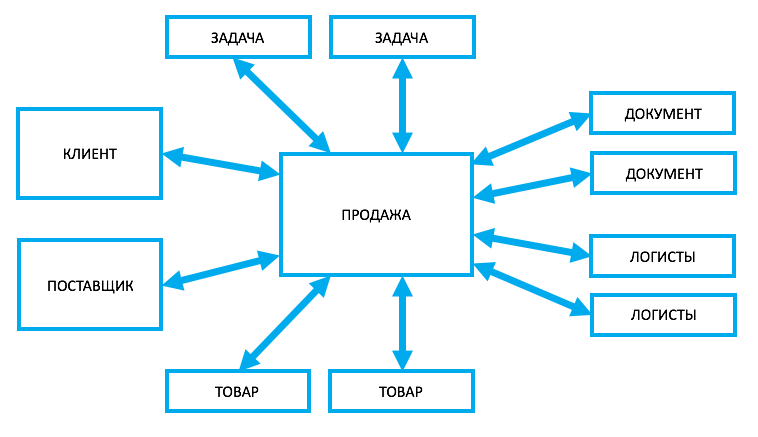
By analogy, we can easily see both the customer and the supplier, logistics companies, goods and documents in the sale card.
What is the supplier connected with?

By analogy, everything else: logistics companies, goods, documents.
The truth in this case, the concept of “sale” has gone beyond just getting money. Here the sale ends with us when the customer received the product we provide. But where it ends we decide for ourselves.
And no matter how complicated all this may seem at the beginning, we build our system from the bricks of entities and connections. And how easy it is to automate all this, so that many processes happen automatically, I will sign it another time.
Although we have already gone beyond the CRM system. But it's not a problem. I wanted you to understand that there is nothing difficult in any system.
And if you go back to the concept of CRM system. Contact list, list of sales with statuses and tasks - this is the simplest example of a CRM system. What can it give you? Any business owner will understand this better than the seller who wants to sell him. And all the rest are moments of convenience that allow for more efficient sales.
In the end, all the same, the system should be what you need, and not what the others planned it. It should automate your business processes, and not become another burden.
This information is not for programmers, IT people, etc. It is for business owners who want to understand what a CRM system is. Do not read about the benefits, benefits, who needs it and what it gives, and above all understand. Most of the information on this topic is written in a very clever language. Even simple articles are written as if people are afraid to appear non-professional. And I ask you to forgive me if someone thinks that I wrote all this in a too simple language. I want you to understand and understand this, because you are good at your business, and did not consider me an expert.

')
So let's break the CRM system apart. What is the CRM system in business? Sales What do we need for sales? Customers Therefore, the first two most important things that we should have, and they are in any CRM system, these are customers and sales.

So. Customers Where do you keep customers? On a piece of paper, on the phone, in the diary, in Excel?
You yourself can confirm that all these options are not convenient because:
- Telephone, mail and other important information about the client may be lost, and with it the client itself.
- The right customer is not so easy to find. Try it, find it among the pile of papers or files.
- It is difficult to keep the whole history of communication with this client. Have you tried to write in detail about each of your clients in a notebook?
Here would save the card index. Like good old times.

The solution is excellent. But there is a drawback. Speed!
- The speed of searching for the necessary information is very low. Try to quickly find the right person in the file. And now a few.
- The speed of entering information is also low.
However, the comparison with the file is good because everyone understands how the file works.
So let's transfer the principle of filing cabinets to a computer.
What do we have in the file cabinet? A bunch of cards of anything. In our case of customers.
So we will get a card for each client, as in a card index. In this card, we will store all the information on the client. We went into the card, and everything is in full view.
What information will we store?
The one that we need in order to successfully sell and make the right decisions. Such information on the client can be divided into two parts.
- Information that should be on each client: name, mail, telephone, city, as an option what products are interested in him or how he got to our company. Simply put, all the information that can be “decomposed”. Let's call it “basic information about the client”.
- Information that tells us about when we last talked with the client, called, wrote letters, etc. In essence, these are our calls to him, letters, messages, all our comments after calls, i.e. information on interaction with the client.

How will we store it?
Agree that in any system there must be order, otherwise it is no longer a system.
How would we do it in the file cabinet? In the simplest form, we would have the same fields for all customers and cards: telephone, mail, etc. In such fields we can easily put information on type 1.

And what to do with all the information that is associated with customer interactions? She has one feature. It depends on the time. So we will arrange it depending on the time in order to first see the latest information, and then later.

As a result, we have a client card, where all the basic information about the client is stored. It is located in the fields. In the picture below, these fields are on the left. All information about the interaction with the client is based on time. The picture below is on the right.

It remains to solve one more thing. We have not one but many clients. How are we going to post them all? In the card file all the cards are arranged in alphabetical order. In our case, nothing better than the list has not yet been invented.

Making a simple customer list. How many customers are on the list without us. Because we will find the clients we need or we need using a search or using a filter.
And if you enter any CRM system, you will see it. A list of clients, and each client has a card with information about him, as well as a search with a filter.
Thus, we got the first of the main parts of the CRM system. In fact, some of this is enough. Customers are already easy to search and information is not lost.
But someone is missing this. Therefore, let's go further. We want to see what we sold to the client!
What do we do with sales information?
We can indicate all sales information directly on the customer card. However, there are several disadvantages:
- There is too much information in the customer card.
- We are not able to quickly find the necessary information.
But there is a way out.
If we consider information about any sale, then, as in the case of a client, we will be able to break it into two parts:
- Information that should be on each sale: the amount of the sale, the source of the sale (which led to the sale), whether there is a contract for this sale, etc. Simply put, basic information about the sale.
- All interaction with the client, which concerns this particular sale. Sales to one customer can be a lot. For each sale it is important how we communicate with the customer regarding this particular sale.

Then there is a simple solution. If the client and the sale are so similar, then let's make the same card for the sale as for the client. Make a list of all sales, as well as customers, which will be easy to find the right one.
But the sale and the customer still have an important distinction. Selling, unlike the client, is a process. And like any process, it has stages. Those. the sale may begin - we have come into contact with the client, and may be completed - we have completed the sale, or not. There are also stages between the beginning and the end.
For example, first the seller communicates with the customer by phone, then he meets, then he makes a commercial offer to him, then he issues an invoice and receives payment. Each business has its own specifics and its stages. But they are always there. Just because any process has one. Even if you just want to leave the house, you first need to get dressed, open the door, then go out. Already at least three stages.

And it is not necessary that during the transition from the first stage to the last, it will be necessary to go through each stage. You can go outside without clothes. In sales, if a customer called you and said: “I want to buy,” and he knows specifically what he wants to buy, you will not insist on throwing him a commercial offer. You bill him. And in fact, you sell him a commercial offer without a stage. You jump over it. There is nothing wrong.
What do we do with the information on the stages?
- Information on what stage the sale is at, we, like all other information, will be indicated in the sale card.
- Let's make it so that it is more convenient to see at what stage the transaction is.
In the case when we are dealing with a process and there are stages, it is very convenient to see immediately at what stage the process is located, in our case the sale. This is how to go to McDonalds and see on the electronic scoreboard whether your order is ready or not. So here. We just horizontally (in the picture below) have all the stages and under each stage of the sale, the sales that are on it are simply displayed.

Only one thing remains: to link sales and customers.
We have a customer list and a list of sales with cards. But while they are not related.
In fact, this is nothing complicated. For example, when you go to a contact or Facebook, you can go to the list of all friends and from all users of the social network see only your friends. Those. in essence, to see only those who are “friends” with you. So it is here.

We will do so that there will be a section in the client’s card where we can go in and see a list of all the sales of this client and from there we can open the cards of these sales. We will do the same in the sale card so that it is easy to get into the customer card. It turns out that now we have customers and sales related.
This is what you will see when entering any CRM system:
- Separately a list of clients.
- Separately a list of sales.
- Sales that are made to the selected customer.
- The customer to which the selected sale belongs.
To make it even clearer, we look at it all from above, like a football game from the stands.
We can consider a player in football as a player with his characteristics or as a point on the field, as one of 11 figures. Also, look at the top of contacts and customers.
To do this, we introduce a new concept. An entity is a distinguishable object; an object that we can distinguish from another. In our system, we will understand an entity as an entity that is displayed in some way (for example, in the form of a card), has its own input fields (for example, the client’s phone, mail, city; the transaction has a sum) and has connections (in our case, for example, the customer has sales links).
Those. customer and sale are separate entities. And they are connected to each other by connections as in the picture. Multiple sales can be made to one customer;

In order to fully work with customers, only one is missing.
We do not rarely forget that someone needs to call, write, etc. Someone for this uses a diary, someone alarm clock, and someone relies on memory.
Let's add just the opportunity to set ourselves tasks. Fortunately, everything is clear with the tasks. The only question is how they will be displayed in the system.
We use the concept of the essence that we have introduced. We agreed that we understand an entity as an object that is displayed in some way (in the case of a task, it can be a card, just not the same as for a sale and a client), but has its own input fields (for a task it’s deadline, priority and etc.) and has connections (the task is related either to the sale or to the contact).
Those. a task is an entity with its connections.

Where to put the tasks in the system?
First, it is most convenient that they are listed as contacts and sales.
Let's make a separate list, where all our tasks are displayed, in order to see them all and we will carry out them in order. And all of them are connected with the client or with the sale. Therefore, through them we easily get into the customer or sale.
And the second question to which we need to answer: Where to display the tasks in the client's card?
Having them as sales is not very convenient.
Tasks have one feature. The tasks themselves are closely related to the process of communication with the client. We call, communicate, then write a comment, set a task, send a letter. Then on the task again call or go to the meeting. Those. for them it is very important when tasks are set and when they need to be completed.
Therefore, let the tasks be displayed in the same place where the comments and calls. Where there is all the information about the interaction with the client, depending on the time.

If you enter almost any CRM system, you will see it. List of tasks and the ability to set tasks in the sale card and customer card. As a result, we get a sale card, a client card and tasks.
We got a customer base, which stores all the information about them. And they got an understanding of what is being sold. Moreover, due to the stages of sale and the tasks we control these sales, i.e. manage them.
CRM - customer relationship management. Manage? We manage.
In fact, this is the main functionality of the CRM system. But you must admit that driving a Mercedes is much more comfortable than a Zhiguli. So let's give our system a little more. Add features.
Customers and sales may not be enough. Take an example at once more complicated to understand how simple it is.
In addition to customers, we may have: suppliers from whom we take goods to resell; logistics companies with whom we can work to deliver cargo; a list of the goods we sell; documents related to all this - for example, contracts.
It seems to be a lot of things. But remember that we have - the essence and connection. In order to easily understand, we will define that all of this - suppliers, logistics companies, documents and goods - are new entities.

Agree that each of them should have a list and a card. List to easily find the right supplier, product, etc. Card so that there is all the information about them. This question is closed. There is nothing difficult.
All that is left for us is to use our second tool - connections. And to connect these entities with each other and with what we already have - customer, sales, task.
Connections depend on business processes. Consider the option when we buy goods from a supplier and resell it to a customer.
What is the customer connected with?

- Sales that we make to this customer.
- Tasks that we set ourselves or others for this client.
- Documents that we draw up for this client.
By analogy with sales, we can easily see in the client's card the documents that are associated with it.
What is the reason for selling?

- The client to whom we made the sale.
- The supplier who provided us the goods.
- The tasks that we have in connection with this sale.
- Logistics companies that transport cargo from a supplier to a customer.
- The goods that we sold to the client.
- Documents that we draw up in connection with this sale.
By analogy, we can easily see both the customer and the supplier, logistics companies, goods and documents in the sale card.
What is the supplier connected with?

- Products that he provides us.
- The challenges that we face for this supplier.
- Sales in which his product is involved.
- Documents that we have in connection with the interaction with him.
By analogy, everything else: logistics companies, goods, documents.
The truth in this case, the concept of “sale” has gone beyond just getting money. Here the sale ends with us when the customer received the product we provide. But where it ends we decide for ourselves.
And no matter how complicated all this may seem at the beginning, we build our system from the bricks of entities and connections. And how easy it is to automate all this, so that many processes happen automatically, I will sign it another time.
Although we have already gone beyond the CRM system. But it's not a problem. I wanted you to understand that there is nothing difficult in any system.
And if you go back to the concept of CRM system. Contact list, list of sales with statuses and tasks - this is the simplest example of a CRM system. What can it give you? Any business owner will understand this better than the seller who wants to sell him. And all the rest are moments of convenience that allow for more efficient sales.
In the end, all the same, the system should be what you need, and not what the others planned it. It should automate your business processes, and not become another burden.
Source: https://habr.com/ru/post/342446/
All Articles